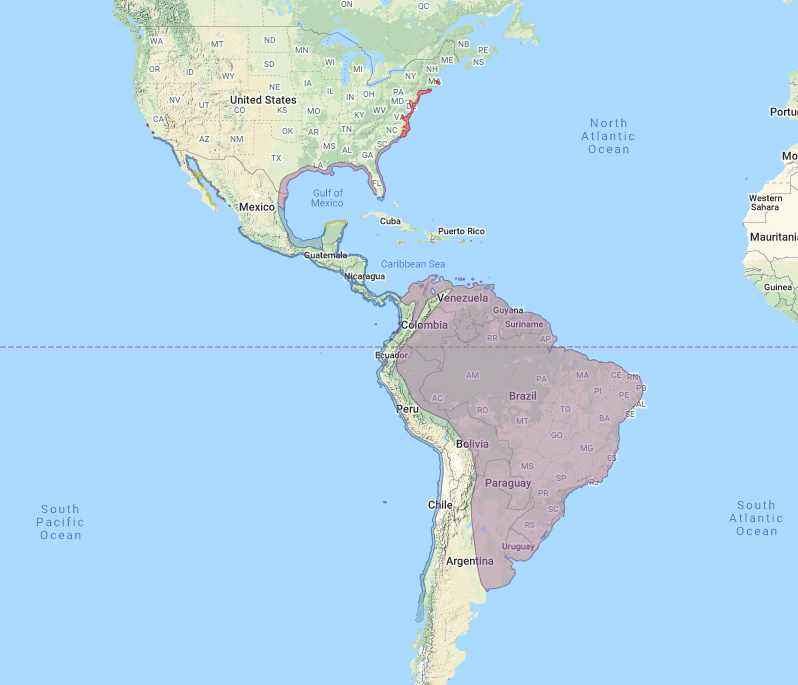Birdfinding.info ⇒ Generally uncommon across most of its large range, but conspicuous when present, and locally abundant in prime habitat in the eastern U.S. along large portions of the Gulf and Atlantic coasts from southern Texas east to the Florida Keys and north to Cape Cod. In South America it is one of the most widespread seabirds, occurring at low densities or sporadically along the majority of its coastlines and large rivers.
Black Skimmer
Rynchops niger
Temperate and tropical coasts of the Americas, and interior river systems of South America.
Breeding. Breeds colonially beside bays, lagoons, estuaries, and other typically calm waterbodies along both coasts of North America from central California and Massachusetts south to El Salvador and the Yucatán Peninsula.
Also breeds along the Caribbean and Atlantic coasts of South America from northern Colombia to Buenos Aires Province, Argentina, and inland throughout much of the continent along many river systems, including the Cauca, Orinoco, Amazon, São Francisco, and Paraná, among others.
Presumably also breeds along the Pacific Coast of South America—at least formerly in southwestern Ecuador, and likely somewhere in Peru and/or Chile, considering that it occurs in significant numbers along their coasts at all times of year.
Movements. Nonbreeders disperse widely within and beyond the breeding range, wandering somewhat farther north along the coasts of North America, to the West Indies, and much more extensively south along the coasts of South America.
In western North America, occasionally wanders north along the California coast, exceptionally to Oregon. In the east, regular in small numbers north to Nova Scotia, and occasionally north to eastern Quebec and Newfoundland. Rarely wanders into the interior of North America beyond the immediate coastal plain except when transported by storms, but it has been recorded casually inland as far as Arizona, Colorado, Kansas, and the Great Lakes.
In the West Indies, regularly visits Cuba, the Bahamas, and Aruba, and occurs as casual vagrant throughout the Greater and Lesser Antilles, with most extralimital records reported from Puerto Rico.
In South America, regularly occurs in large numbers along the Pacific Coast south to Chiloé Island, Chile. On the Atlantic Coast, small numbers regularly wander south to southern Patagonia and Tierra del Fuego.
One exceptional vagrant was photographed near Cape Town, South Africa in October 2012.
Identification
Unique: the only skimmer in its range, readily identifiable by its abnormally long lower mandible and trademarked feeding style—plying the surface until it hits a fish, then snapping its bill shut.
A clownish, gull-like seabird whose anatomy is tailored to support its extraordinarily exaggerated bill—the laterally compressed, lower mandible is deeper and about 20-30% longer than the upper mandible. The bill is mostly black, but orange or coral-red at the base—unlike its closely related Old World counterparts, the geographically distant African and Indian Skimmers, whose bills are similar but all or mostly orange.
Topheavy structure evident at rest and in flight. The tail is short and the head and neck are large, and the lower mandible is disproportionately larger.

Black Skimmer, breeding plumage. (Port Aransas, Texas; May 10, 2019.) © Eric Carpenter
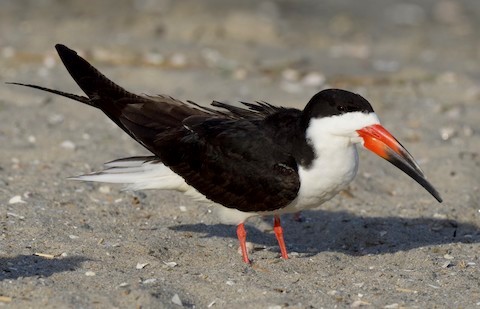
Black Skimmer, breeding plumage. (Short Beach Park, Stratford, Connecticut; June 8, 2020.) © L. Olsen
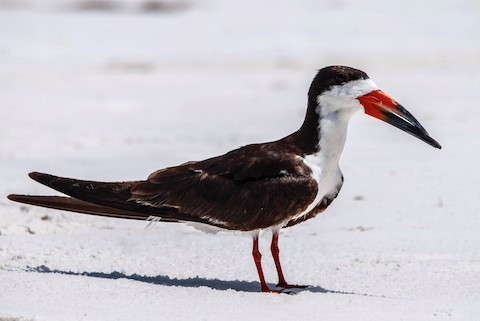
Black Skimmer, breeding plumage. (Destin, Florida; August 3, 2018.) © Andrew Simon
Adults have mostly blackish upperparts and white underparts—extending across the lower half of the face to the forehead.
In breeding plumage, the upperparts are jet-black and crisply defined.
In nonbreeding plumage, the blackish coloration becomes washed out and brownish or grayish, and less extensive on the head and nape—leaving it with a dark cap.

Black Skimmer, breeding plumage. (Plymouth, Massachusetts; August 16, 2014.) © Ian Davies

Black Skimmer, nonbreeding plumage. (Fort Pierce, Florida; January 8, 2019.) © Matthew Beziat
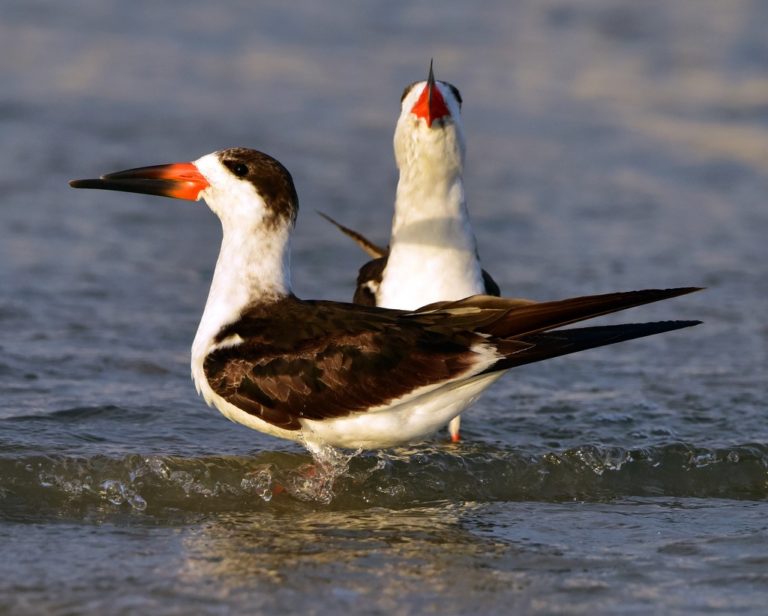
Black Skimmer, nonbreeding plumage—note frontal view of bill showing lateral compression to knife-like shape to enable skimming. (Sebastian Inlet, Florida; January 29, 2017.) © Edward Perry IV
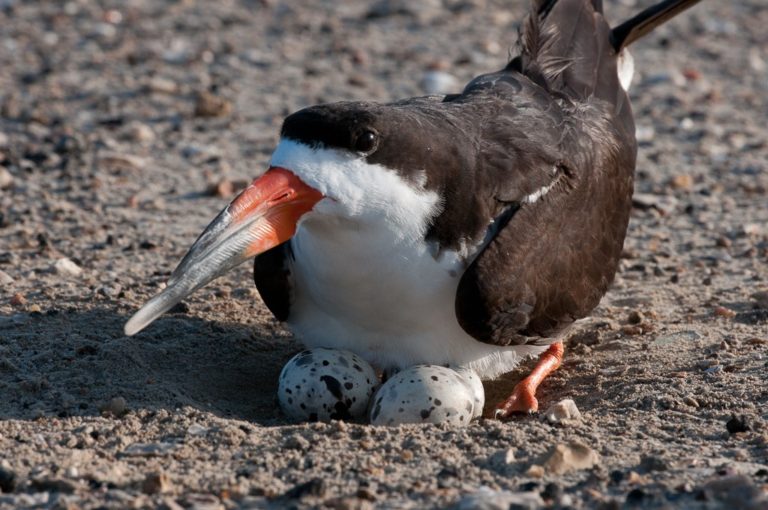
Black Skimmer at nest. (Texas City, Texas; July 22, 2011.) © Scott Buckel

Black Skimmer, breeding plumage, frontal view of bill showing lateral compression to knife-like shape to enable skimming. (Short Beach Park, Stratford, Connecticut; June 8, 2020.) © L. Olsen

Black Skimmer, breeding plumage. (Short Beach Park, Stratford, Connecticut; June 8, 2020.) © L. Olsen

Black Skimmer, breeding plumage. (Nickerson Beach, New York; August 8, 2019.) © Dorian Anderson
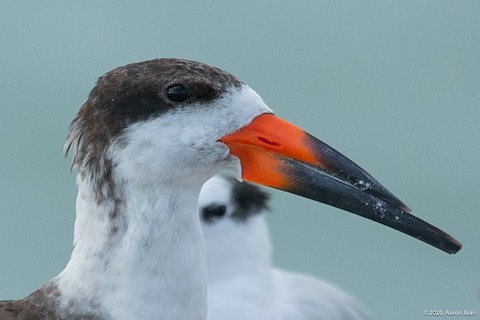
Black Skimmer, nonbreeding plumage. (Belize City, Belize; January 23, 2020.) © Aaron Juan

Black Skimmer, nonbreeding plumage. (Foster City, California; January 23, 2018.) © Dorian Anderson
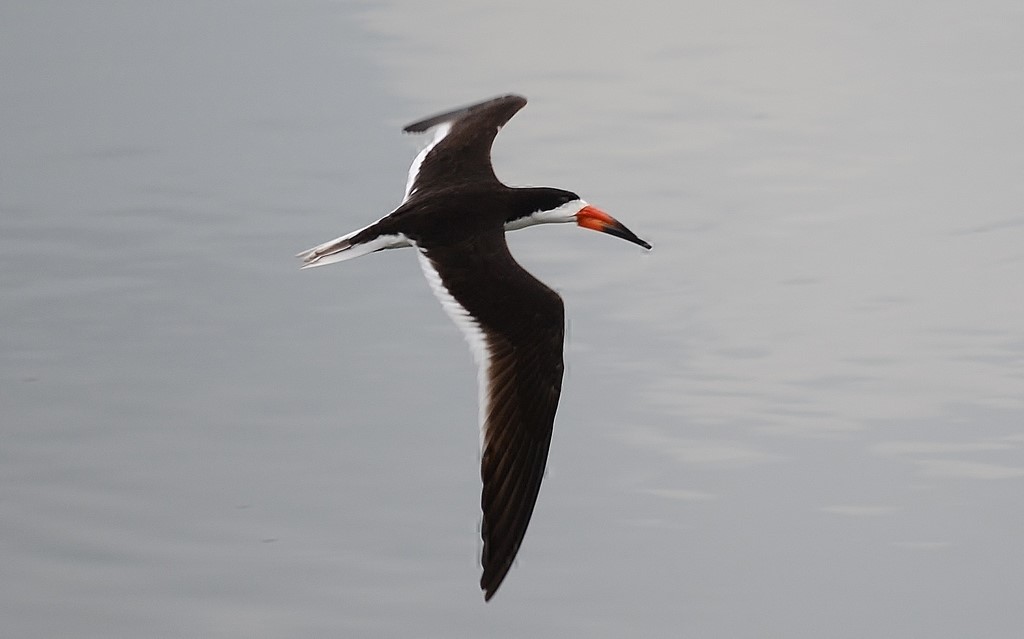
Black Skimmer, breeding plumage. (Edinburg Scenic Wetlands, Texas; June 19, 2015.) © Javi Gonzalez
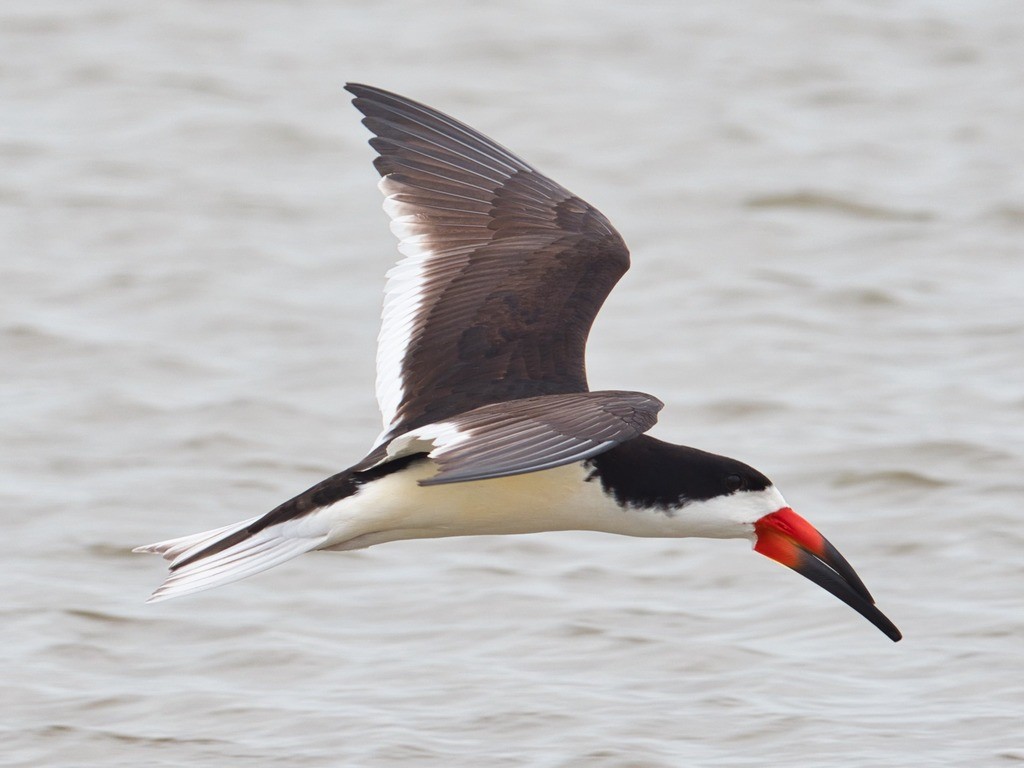
Black Skimmer, showing black bar down center of rump and tail. (Port Aransas, Texas; May 10, 2019.) © Eric Carpenter
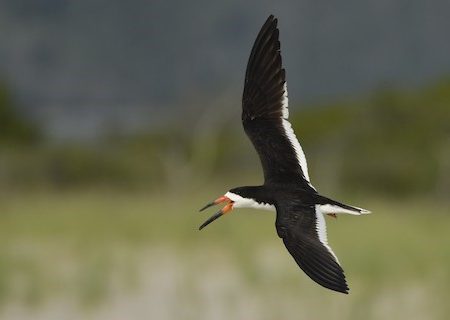
Black Skimmer, breeding plumage. (Assateague Island, Maryland; July 27, 2020.) © Jonathan Irons

Black Skimmer, carrying prey. (Nickerson Beach, New York; August 5, 2019.) © Dorian Anderson
Geographical Variation. In the subspecies of North America (niger) and southeastern South America (intercedens) the tail and rump are mostly white or whitish, with a narrow black bar down the middle. The underwings generally appear white overall.
The subspecies cinerascens of northern and western South America differs in having a mostly dark rump, tail, and underwings.
(Note that while these differences are fairly consistent and striking, they are not absolute. Many individual cinerascens have comparatively pale plumage, especially white underwings, and some niger have variably dark tails. In some areas, darker and paler individuals occur together, and it is not clear that they originate from different breeding populations.)

Black Skimmer, R. n. cinerascens, showing the dark underwings and tail typical of this subspecies. (Iranduba, Amazonas, Brazil; December 1, 2019.) © Estevão Santos
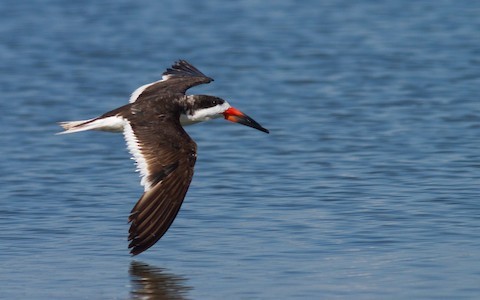
Black Skimmer, molting out of breeding plumage. (Biddeford, Maine; September 21, 2019.) © Fyn Kynd
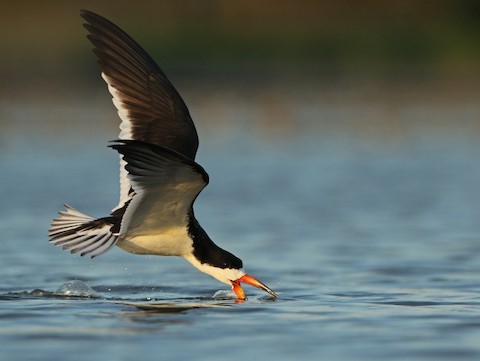
Black Skimmer, skimming, showing mixed white and blackish tail feathers. (Heislerville Wildlife Management Area, Maurice River, New Jersey; May 10, 2017.) © Luke Seitz

Black Skimmer, R. n. cinerascens, molting out of breeding plumage. (Bubali Bird Sanctuary, Aruba; May 30, 2020.) © Michiel Oversteegen
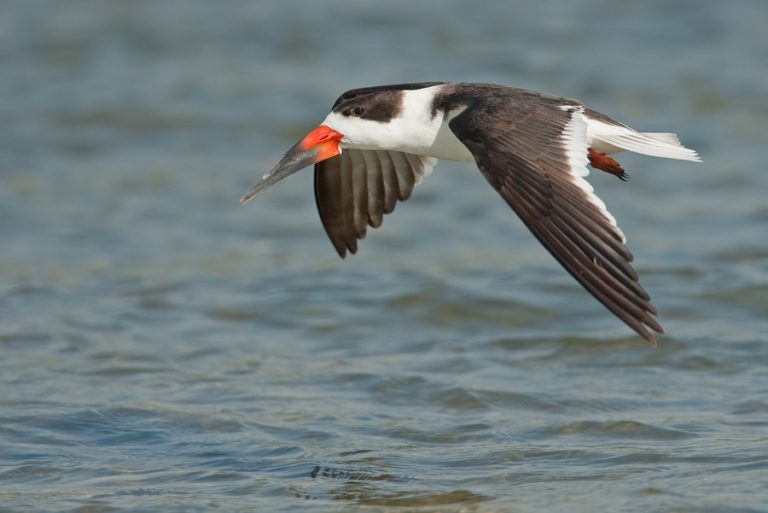
Black Skimmer. (San Carlos Bay – Bunche Beach Preserve, Fort Meyers, Florida; February 16, 2009.) © Paul Cools
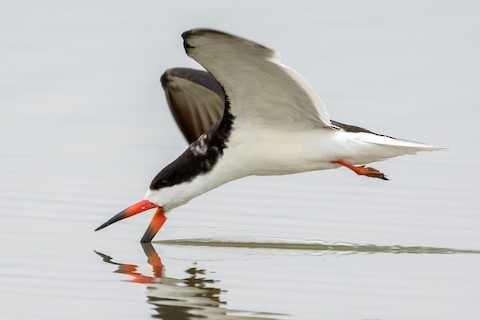
Black Skimmer, skimming. (Galveston, Texas; December 31, 2019.) © Juan Miguel Artigas Azas
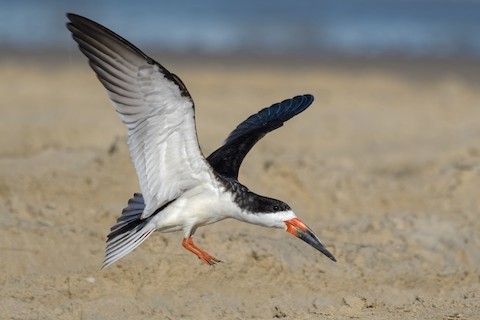
Black Skimmer, showing mixed white and blackish tail feathers. (Ocean City, Maryland; October 14, 2020.) © Don Danko

Black Skimmer, showing almost all-white underparts, typical of most populations. (Galveston, Texas; December 31, 2019.) © Juan Miguel Artigas Azas

Black Skimmer. (Imperial Beach, California; September 5, 2009.) © BJ Stacey
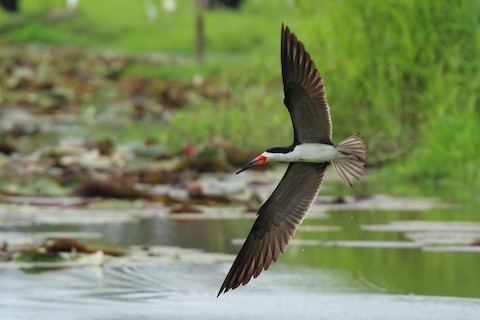
Black Skimmer, R. n. cinerascens, showing the dark underwings and tail typical of this subspecies. (Iranduba, Amazonas, Brazil; December 1, 2019.) © Estevão Santos
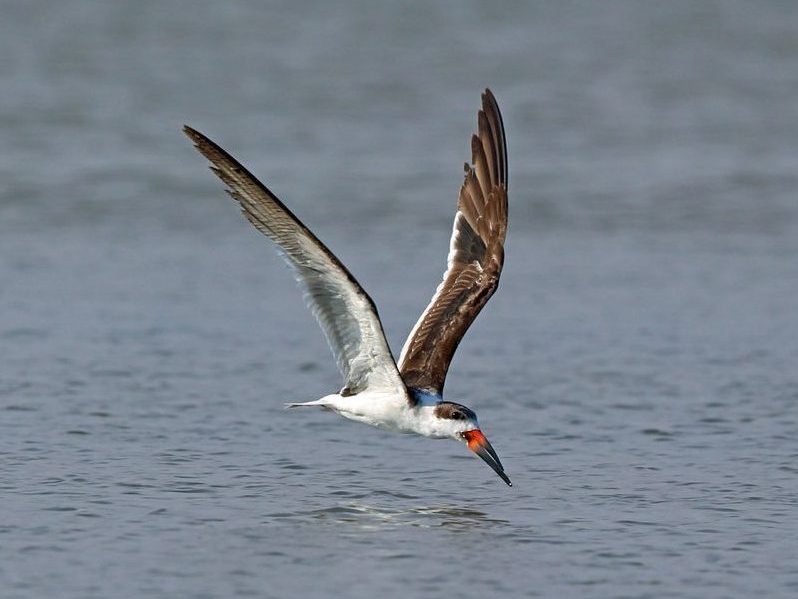
Black Skimmer, immature showing patchy brown and black on upperparts. (Ensenada la Ventosa, Oaxaca, Mexico; March 24, 2015.) © Nigel Voaden

Black Skimmer, with its landing gear extended—note the disproportionately large head and neck, and more disproportionately large lower mandible. (Bubali Bird Sanctuary, Aruba; July 7, 2019.) © Michiel Oversteegen
Immature Plumages. Juveniles have mostly brownish or charcoal-gray upperparts with pale feather-edges, and mostly whitish heads.
Older immatures resemble adults but tend to be more brownish or grayish and paler on the head.

Black Skimmer, juvenile. (Parque Ecológico Metropolitano, León, Guanajuato, Mexico; August 18, 2019.) © Juan Miguel Artigas Azas
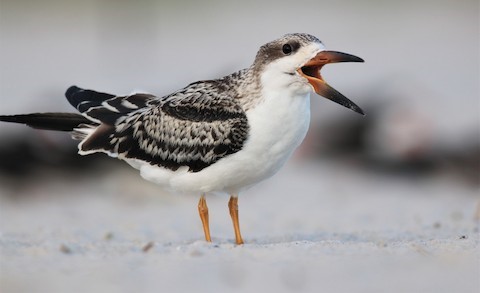
Black Skimmer, juvenile. (Lido Beach, New York; September 7, 2020.) © Brendan Fogarty

Black Skimmer, juvenile. (Barão de Melgaço, Mato Grosso, Brazil; October 10, 2014.) © John R. Eppler

Black Skimmer, juvenile. (Wollaston Beach, Massachusetts; October 13, 2018.) © Max McCarthy
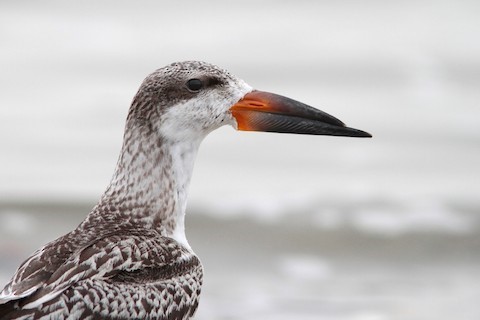
Black Skimmer, juvenile. (Pine Point, Scarborough, Maine; October 3, 2012.) © Doug Hitchcox
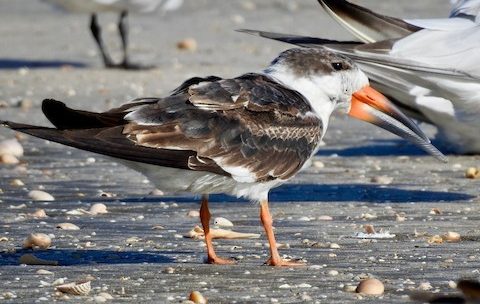
Black Skimmer, juvenile molting into immature plumage. (Rutherford Beach, Oak Grove, Louisiana; October 13, 2018.) © Van Remsen

Black Skimmer, juvenile. (Ocean City, Maryland; October 13, 2020.) © Don Danko

Black Skimmer, immature. (South Padre Island, Texas; February 16, 2015.) © Joshua Lincoln
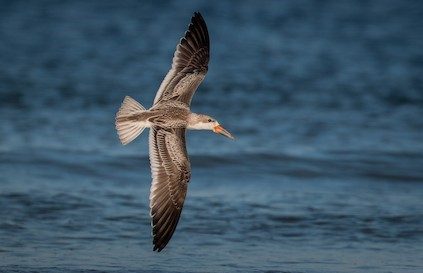
Black Skimmer, juvenile. (Plymouth, Massachusetts; September 9, 2016.) © Ian Davies
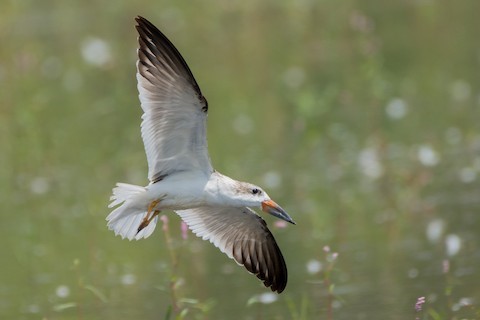
Black Skimmer, juvenile. (Parque Ecológico Metropolitano, León, Guanajuato, Mexico; August 18, 2019.) © Juan Miguel Artigas Azas
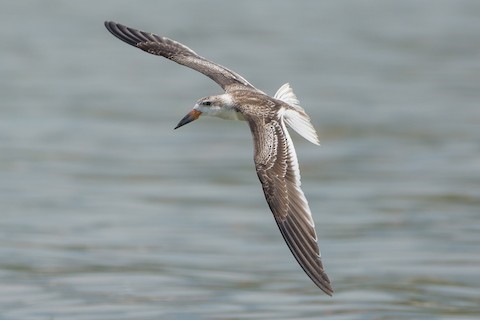
Black Skimmer, juvenile. (Parque Ecológico Metropolitano, León, Guanajuato, Mexico; August 18, 2019.) © Juan Miguel Artigas Azas

Black Skimmer, juvenile, skimming. (Wollaston Beach, Massachusetts; October 13, 2018.) © Jeremiah Trimble
Notes
Polytypic species consisting of three recognized subspecies.
References
Alderfer, J., and J.L. Dunn. 2014. National Geographic Complete Birds of North America (Second Edition). National Geographic Society, Washington, D.C.
Ascanio, D., G.A. Rodriguez, and R. Restall. 2017. Birds of Venezuela. Christopher Helm, London.
Aves de Chile. 2020. Rayador. https://www.avesdechile.cl/091.htm. (Accessed December 10, 2020.)
BirdLife International. 2016. Rynchops niger. The IUCN Red List of Threatened Species 2016: e.T22694256A93442996. https://dx.doi.org/10.2305/IUCN.UK.2016-3.RLTS.T22694256A93442996.en. (Accessed December 10, 2020.)
de la Peña, M.R., and M. Rumboll. 1998. Birds of Southern South America and Antarctica. Princeton University Press.
eBird. 2020. eBird: An online database of bird distribution and abundance. Cornell Lab of Ornithology, Ithaca, N.Y. http://www.ebird.org. (Accessed December 10, 2020.)
Fagan, J., and O. Komar. 2016. Peterson Field Guide to the Birds of Northern Central America. Houghton Mifflin Harcourt, New York.
ffrench, R. 2012. A Guide to the Birds of Trinidad & Tobago (Third Edition). Cornell University Press.
Harrison, P. 1983. Seabirds: An Identification Guide. Houghton Mifflin, Boston.
Howell, S.N.G., and S. Webb. 1995. A Guide to the Birds of Mexico and Northern Central America. Oxford University Press.
Jaramillo, A. 2003. Birds of Chile. Princeton University Press.
Kirwan, G.M., A. Levesque, M. Oberle, and C.J. Sharpe. 2019. Birds of the West Indies. Lynx Edicions, Barcelona.
McMullan, M., and T. Donegan. 2014, Field Guide to the Birds of Colombia (Second Edition). Fundación Proaves de Colombia, Bogotá.
Raffaele, H., J. Wiley, O. Garrido, A. Keith, and J. Raffaele. 1998. A Guide to the Birds of the West Indies. Princeton University Press, Princeton, N.J.
Ridgely, R.S., and P.J. Greenfield. 2001. The Birds of Ecuador, Volume II: Field Guide. Cornell University Press.
Ridgely, R.S., and J.A. Gwynne. 1989. A Guide to the Birds of Panama (Second Edition). Princeton University Press.
Schulenberg, T.S., D.F. Stotz, D.F. Lane, J.P. O’Neill, and T.A. Parker. 2007. Birds of Peru. Princeton University Press.
Sibley, D.A. 2000. The Sibley Guide to Birds. Alfred A. Knopf. New York.
van Perlo, B. 2009. A Field Guide to the Birds of Brazil. Oxford University Press.
Wells, J.V., and A.C. Wells. 2017. Birds of Aruba, Bonaire, and Curaçao. Cornell University Press.
Wikiaves. 2020. Talha-mar, https://www.wikiaves.com.br/wiki/talha-mar. (Accessed December 9, 2020.)
Xeno-Canto. 2020. Black Skimmer – Rynchops niger. https://www.xeno-canto.org/species/Rynchops-niger. (Accessed December 9, 2020.)

